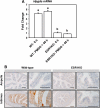Hematopoetic prostaglandin D synthase: an ESR1-dependent oviductal epithelial cell synthase
- PMID: 22374975
- PMCID: PMC3320253
- DOI: 10.1210/en.2011-1900
Hematopoetic prostaglandin D synthase: an ESR1-dependent oviductal epithelial cell synthase
Abstract
Oviductal disease is a primary cause of infertility, a problem that largely stems from excessive inflammation of this key reproductive organ. Our poor understanding of the mechanisms regulating oviductal inflammation restricts our ability to diagnose, treat, and/or prevent oviductal disease. Using mice, our objective was to determine the spatial localization, regulatory mechanism, and functional attributes of a hypothesized regulator of oviductal inflammation, the hematopoietic form of prostaglandin D synthase (HPGDS). Immunohistochemistry revealed specific localization of HPGDS to the oviduct's epithelium. In the isthmus, expression of HPGDS was consistent. In the ampulla, expression of HPGDS appeared dependent upon stage of the estrous cycle. HPGDS was expressed in the epithelium of immature and cycling mice but not in the oviducts of estrogen receptor α knockouts. Two receptor subtypes bind PGD₂: PGD₂ receptor and G protein-coupled receptor 44. Expression of mRNA for Ptgdr was higher in the epithelial cells (EPI) than in the stroma (P < 0.05), whereas mRNA for Gpr44 was higher in the stroma than epithelium (P < 0.05). Treatment of human oviductal EPI with HQL-79, an inhibitor of HPGDS, decreased cell viability (P < 0.05). Treatment of mice with HQL-79 increased mRNA for chemokine (C-C motif) ligands 3, 4, and 19; chemokine (C-X-C motif) ligands 11 and 12; IL-13 and IL-17B; and TNF receptor superfamily, member 1b (P < 0.02 for each mRNA). Overall, these results suggest that HPGDS may play a role in the regulation of inflammation and EPI health within the oviduct.
Figures





Similar articles
-
Intestinal tumor suppression in ApcMin/+ mice by prostaglandin D2 receptor PTGDR.Cancer Med. 2014 Aug;3(4):1041-51. doi: 10.1002/cam4.251. Epub 2014 Apr 12. Cancer Med. 2014. PMID: 24729479 Free PMC article.
-
Inhibition of prostaglandin D synthase suppresses muscular necrosis.Am J Pathol. 2009 May;174(5):1735-44. doi: 10.2353/ajpath.2009.080709. Epub 2009 Apr 9. Am J Pathol. 2009. PMID: 19359520 Free PMC article.
-
Protective role of hematopoietic prostaglandin D synthase in transient focal cerebral ischemia in mice.Neuroscience. 2009 Sep 29;163(1):296-307. doi: 10.1016/j.neuroscience.2009.06.027. Epub 2009 Jun 13. Neuroscience. 2009. PMID: 19531375
-
Expression and detrimental role of hematopoietic prostaglandin D synthase in spinal cord contusion injury.Glia. 2011 Apr;59(4):603-14. doi: 10.1002/glia.21128. Epub 2011 Feb 3. Glia. 2011. PMID: 21294159
-
Therapeutic Potential of Hematopoietic Prostaglandin D2 Synthase in Allergic Inflammation.Cells. 2019 Jun 20;8(6):619. doi: 10.3390/cells8060619. Cells. 2019. PMID: 31226822 Free PMC article. Review.
Cited by
-
The role of estrogen in the pathophysiology of tubal ectopic pregnancy.Am J Transl Res. 2012;4(3):269-78. Epub 2012 Jul 20. Am J Transl Res. 2012. PMID: 22937205 Free PMC article.
-
A transcriptomal analysis of bovine oviductal epithelial cells collected during the follicular phase versus the luteal phase of the estrous cycle.Reprod Biol Endocrinol. 2015 Aug 5;13:84. doi: 10.1186/s12958-015-0077-1. Reprod Biol Endocrinol. 2015. PMID: 26242217 Free PMC article.
-
Bioinformatics analysis to reveal the potential comorbidity mechanism in psoriasis and nonalcoholic steatohepatitis.Skin Res Technol. 2023 Sep;29(9):e13457. doi: 10.1111/srt.13457. Skin Res Technol. 2023. PMID: 37753698 Free PMC article.
-
Functional Analogy in Human Metabolism: Enzymes with Different Biological Roles or Functional Redundancy?Genome Biol Evol. 2017 Jun 1;9(6):1624-1636. doi: 10.1093/gbe/evx119. Genome Biol Evol. 2017. PMID: 28854631 Free PMC article.
-
Metabolome and transcriptome analyses reveal the mechanism underlying the differences in skin development between the two duck breeds during embryonic stage.Poult Sci. 2025 Jun 6;104(9):105403. doi: 10.1016/j.psj.2025.105403. Online ahead of print. Poult Sci. 2025. PMID: 40499236 Free PMC article.
References
-
- Confino E, Radwanska E. 1992. Tubal factors in infertility. Curr Opin Obstet Gynecol 4:197–202 - PubMed
-
- Kodaman PH, Arici A, Seli E. 2004. Evidence-based diagnosis and management of tubal factor infertility. Curr Opin Obstet Gynecol 16:221–229 - PubMed
-
- Wright VC, Chang J, Jeng G, Macaluso M. 2006. Assisted reproductive technology surveillance—United States, 2003. MMWR Surveill Summ 55:1–22 - PubMed
-
- Wright VC, Chang J, Jeng G, Chen M, Macaluso M. 2007. Assisted reproductive technology surveillance—United States, 2004. MMWR Surveill Summ 56:1–22 - PubMed
-
- Wright VC, Chang J, Jeng G, Macaluso M. 2008. Assisted reproductive technology surveillance—United States, 2005. MMWR Surveill Summ 57:1–23 - PubMed
Publication types
MeSH terms
Substances
Grants and funding
LinkOut - more resources
Full Text Sources
Molecular Biology Databases
Miscellaneous

